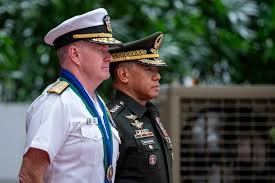In a significant move that underscores the strengthening of military relations between the United States and the Philippines, Admiral John C. Aquilino, Commander of U.S. Indo-Pacific Command (INDOPACOM), has made an official visit to Manila. During his trip, which began on [Insert Date], Admiral Aquilino met with senior officials from the Philippine government and military to discuss pressing security challenges in the Indo-Pacific region, including increasing geopolitical tensions, defense cooperation, and strategies to ensure regional stability.
The visit comes at a time when security issues in the South China Sea and other parts of the region have reached new levels of urgency, with China’s military expansion and maritime claims intensifying. In addition to bilateral defense relations, the discussions also covered the broader strategic landscape, particularly how both countries plan to address emerging threats in the Pacific region.
Strengthening Defense Cooperation
One of the key themes during the discussions was the enhancement of defense cooperation between the U.S. and the Philippines. As a long-time ally, the Philippines plays a crucial role in the U.S.’s broader Indo-Pacific strategy. This trip marks a continued commitment to deepening military partnerships in the face of evolving threats posed by both state and non-state actors.
Admiral Aquilino emphasized the importance of strengthening military ties and improving the readiness of both nations’ armed forces. He also highlighted the need for joint training exercises, humanitarian assistance operations, and enhanced intelligence sharing to better address regional security challenges.
Rising Tensions in the South China Sea
The ongoing tensions in the South China Sea have been a central focus of the talks. Over the past decade, China has increasingly asserted its territorial claims over large portions of the sea, despite competing claims from several Southeast Asian nations, including the Philippines. The U.S. has repeatedly voiced concerns about China’s actions in the region, which include building artificial islands and deploying military assets to contested areas.
Aquilino’s visit comes at a time when the Philippines is grappling with the growing Chinese presence in the South China Sea. In recent months, there have been reports of Chinese vessels encroaching on Philippine-claimed territories, which has raised concerns among both the Philippine government and its allies, including the United States. The U.S. has reaffirmed its commitment to defending Philippine territory under the mutual defense pact between the two nations, which dates back to 1951.
Admiral Aquilino reiterated that the U.S. would continue to support the Philippines in safeguarding its territorial integrity, noting that the South China Sea is a critical waterway for international trade, and its stability is vital for global security.
Addressing China’s Growing Military Presence
China’s military buildup and presence in the region were a significant part of the talks between Admiral Aquilino and Philippine officials. In particular, the presence of Chinese military and civilian vessels near disputed areas has raised alarms about potential confrontations. The U.S. Indo-Pacific Command has been monitoring China’s actions closely, with Aquilino stressing the need for a united front to counter China’s militarization of the region.
The visit also underscored the importance of maintaining a free and open Indo-Pacific, where international laws and norms are respected. Both the U.S. and the Philippines have expressed concerns about China’s attempts to assert control over the region, particularly through its Belt and Road Initiative and other infrastructure projects that further entrench its presence.
Expanding Joint Exercises and Humanitarian Assistance
One of the highlights of the discussions was the agreement to expand joint military exercises between the U.S. and the Philippines. These exercises are designed to increase the interoperability of both nations’ forces, strengthen regional security, and provide a platform for humanitarian assistance and disaster relief in the event of natural disasters.
The Philippines, being prone to natural disasters like typhoons, earthquakes, and volcanic eruptions, benefits from the U.S.’s logistical capabilities and expertise in disaster response. In recent years, the U.S. military has played a crucial role in providing humanitarian aid to the Philippines during emergencies. Both countries have committed to further enhancing their disaster response capabilities to ensure they can respond quickly and effectively to future crises.
The expanded joint exercises will also cover a wider range of scenarios, from counterterrorism operations to humanitarian missions, to ensure that both militaries are prepared for any eventuality. This closer collaboration will enhance the capacity of the Philippine military to defend its borders and secure its interests, while also contributing to regional stability.
Regional Security Challenges and the North Korean Threat
Aside from China, regional security concerns include the ongoing threat posed by North Korea’s missile and nuclear ambitions. The U.S. and the Philippines have reaffirmed their commitment to countering North Korea’s provocations, which threaten the stability of the broader Indo-Pacific region.
North Korea’s continued development of ballistic missiles and nuclear weapons has led to increased tensions in the region. The Philippines, while geographically distant from the Korean Peninsula, is nevertheless part of the larger Indo-Pacific security framework, and its role in the broader efforts to counter North Korean aggression remains significant.
Admiral Aquilino stressed the importance of continued collaboration between the U.S. and the Philippines to prevent North Korea from further destabilizing the region. As part of their security cooperation, the two countries are also focused on enhancing missile defense capabilities, improving intelligence-sharing, and coordinating diplomatic efforts to contain North Korea’s growing threat.
Reaffirming the Mutual Defense Pact
A key aspect of the visit was the reaffirmation of the U.S.-Philippines Mutual Defense Treaty, which has served as the cornerstone of their security relationship since it was signed in 1951. Under this treaty, both nations are obligated to come to each other’s aid in the event of an armed attack. This mutual defense pact has been vital in maintaining peace and stability in the region, especially in the face of increasing geopolitical tensions.
Admiral Aquilino expressed the U.S.’s unwavering commitment to honoring its obligations under the treaty, underscoring the importance of the partnership with the Philippines in maintaining regional peace and security. He also called for continued dialogue and cooperation on defense matters, emphasizing that the U.S. and the Philippines must work together to address both traditional and emerging security threats.
Strengthening the U.S.-Philippines Alliance
The visit by Admiral Aquilino highlights the growing importance of the U.S.-Philippines defense relationship in the evolving security landscape of the Indo-Pacific. As China continues to assert its influence in the region and as North Korea’s provocations persist, the need for strong, strategic partnerships is more critical than ever. The U.S. and the Philippines are committed to working together to address these challenges and ensure the security of the Indo-Pacific region.
As part of the broader Indo-Pacific strategy, the U.S. is also focused on reinforcing its alliances and partnerships with countries like Japan, South Korea, and Australia. The Philippines remains a key partner in this strategy, given its strategic location and role in safeguarding the region’s sea lanes and airspace.
In conclusion, Admiral Aquilino’s visit to the Philippines has reinforced the importance of the U.S.-Philippines alliance in addressing the complex security challenges facing the Indo-Pacific region. By strengthening military cooperation, expanding joint exercises, and tackling issues like China’s growing military presence and North Korea’s nuclear threat, both nations are working toward a more secure and stable future for the region. The mutual commitment to shared security goals reflects a deepening relationship that will continue to evolve as the geopolitical landscape shifts in the coming years.

US Business Activity Slows as Service Sector Growth Declines





